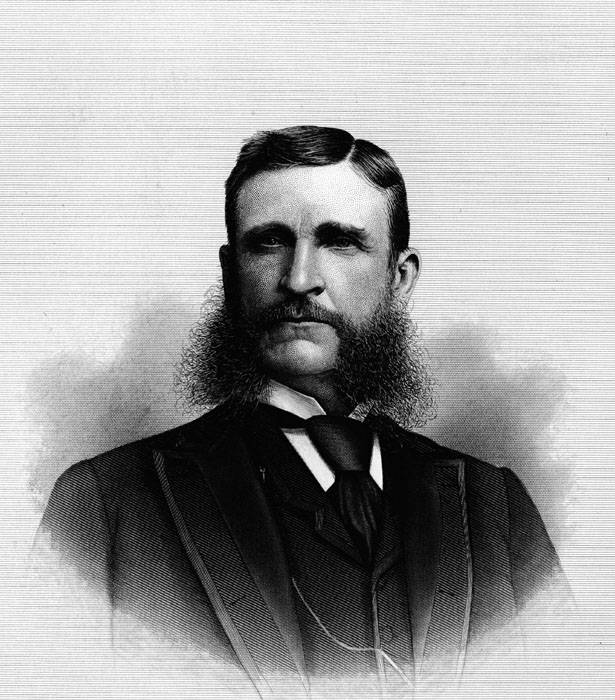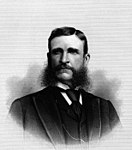1895 Utah gubernatorial election
Contributors to Wikimedia projects
 Article Images
Article Images
The 1895 Utah gubernatorial election was held on November 3, 1895. It was the first gubernatorial election in the state of Utah and it was held before it became a state on the 4 of January, 1896, to set up the machinery for the new state. Republican Heber Manning Wells defeated Democratic nominee John Thomas Caine with 50.32% of the vote. Wells' first term was to run for five years, until the next general election in 1900. Also, Populist Henry W. Lawrence ran but only won 4.95% of the vote.
| |||||||||||||||||
| |||||||||||||||||
 County results | |||||||||||||||||
| |||||||||||||||||
The Utah Territory had been granted statehood after a constitutional convention was held between March 4, 1895, to May 8, 1895.[1] The territory had applied for statehood multiple times before, but the practice of polygamy among the Mormon population was one of the main reasons the federal government refused the proposals.[2] In 1890, the LDS church banned the practice of polygamy in a new manifesto, paving the way for statehood.[3] In 1892, Utah's non-voting representative Joseph L. Rawlins worked with Republicans and Democrats in congress to pass the Enabling Act, signed by the President Grover Cleveland in 1894, which allowed for the state to organize another constitutional convention for statehood the following year.[4][5] After a constitution was approved by Utah's delegates, statewide elections were held in November in preparation for statehood on January 4th, 1896.
Heber Manning Wells, a delegate to the Utah constitutional convention, and a previous tax collector and city recorder, ran for the Republican nomination against the party's chair Charles Crane and former territorial governor Arthur L. Thomas, and won.[6] The Ogden Daily Standard reported that Crane was "defeated by those whom he trusted; by those in whom he believed; by those whom he had honored;..." As for Thomas, the Standard stated that he "...laid on the slaughter blocks and [got] completely annihilated. In fact he was not even considered as a possible candidate."[7] John Thomas Cain, a former congressman who was instrumental in guiding Utah towards statehood, while also protecting the rights of polygamous Mormons,[8] won the Democratic nomination.
The race centered on both men's personality, with Wells being seen as young, intelligent, progressive, and able to bring a fresh face for the new Utah state, but criticized for being inexperienced and was attached to allegations about state Republican's financial issues. Caine was seen as experienced, but being from the now old territory era, and being of older age, hurt him.[9][10] The Salt Lake Tribune (in favor of Wells) and the Salt Lake Herald-Republican (in favor of Caine) both engaged in mud slinging against each other, and both believed it would either be a Republican or Democratic year before election day.[11][12] Ultimately, it would be a Republican year, with Wells winning against Caine with 50.32% of the vote against his 44.73%, and Republican's taking control of the state legislature.[13]
Wells's first term would be dominated by setting up the new state's foundations and systems. In the legislature's first session, which lasted 90 days, 60 bills were sent to Wells to sign, many dealing with the basic organization of state courts and offices, election reform (including the secret ballot), and codification of laws. Wells also wanted railroad regulation, but his proposal was rejected. In 1897, he would also establish the state's first laws dealing with irrigation and water rights.[6]
- ^ "Utah Constitutional Convention". le.utah.gov. Retrieved August 13, 2024.
- ^ "The Path to Utah Statehood | American Experience | PBS". www.pbs.org. Retrieved August 13, 2024.
- ^ "Deseret Evening News | 1890-09-25 | Page 2 | Official Declaration". newspapers.lib.utah.edu. Retrieved August 13, 2024.
- ^ "Constitutional Convention (1895) Records and Dockets | Utah Division of Archives and Records Service". archives.utah.gov. Retrieved August 13, 2024.
- ^ White, Jean (April 11, 2011). The Utah State Constitution. Oxford. pp. 11–42. ISBN 9780199779284.
- ^ a b "Heber Manning Wells | History to Go". historytogo.utah.gov. Retrieved August 13, 2024.
- ^ "Ogden Daily Standard | 1895-08-29 | Page 2 | Hon, Chas Crane". newspapers.lib.utah.edu. Retrieved August 13, 2024.
- ^ Roderick, Judith (1959). "A Historical Study of the Congressional Career, John T. Caine". Theses and Dissertations: 128–129.
- ^ "Salt Lake Herald-Republican | 1895-09-21 | Page 1 | Wells Will Grow Weak". newspapers.lib.utah.edu. Retrieved August 13, 2024.
- ^ "Salt Lake Tribune | 1895-11-05 | Page 4 | Hon. Heber M. Wells". newspapers.lib.utah.edu. Retrieved August 13, 2024.
- ^ "Salt Lake Tribune | 1895-11-05 | Page 1". newspapers.lib.utah.edu. Retrieved August 13, 2024.
- ^ "Salt Lake Herald-Republican | 1895-10-10 | Page 4 | This is a Democratic Year". newspapers.lib.utah.edu. Retrieved August 13, 2024.
- ^ "Salt Lake Tribune | 1895-11-07 | Page 1". newspapers.lib.utah.edu. Retrieved August 13, 2024.
- ^ Kalb, Deborah (December 24, 2015). Guide to U.S. Elections. ISBN 9781483380353. Retrieved August 5, 2020.
- "Utah Election history". Utah History Encyclopedia. University of Utah Press.
- "1895 Utah gubernatorial election". OurCampaigns.com.

